6JSC Chair 2 Examples group charge - Joint Steering Committee for ...
6JSC Chair 2 Examples group charge - Joint Steering Committee for ...
6JSC Chair 2 Examples group charge - Joint Steering Committee for ...
Create successful ePaper yourself
Turn your PDF publications into a flip-book with our unique Google optimized e-Paper software.
Members of the Group will be provided with access to RDA Toolkit.<br />
It is expected that the <strong>group</strong> will work by email or use tools <strong>for</strong> document sharing.<br />
<strong>6JSC</strong>/<strong>Chair</strong>/2<br />
April 3, 2012<br />
Page 2/4<br />
General guidance <strong>for</strong> <strong>Examples</strong><br />
1. Prefer examples with literary warrant wherever possible.<br />
2. Provide simple and clear cut examples. If an example has the potential to confuse, don’t<br />
include it.<br />
3. <strong>Examples</strong> should not introduce anything which itself would require explanation (e.g.,<br />
words that need to be defined).<br />
4. The language preferred by the agency should be taken as English. Likewise, the script<br />
preferred by the agency should be taken as roman.<br />
5. Follow Appendices A-E.<br />
CONTEXTUAL EXAMPLES<br />
Form of the contextual examples<br />
Language and script of examples<br />
• Each example should follow the instruction that it illustrates with respect to language and<br />
script. Note: specific instructions may override the instructions on Language and script of<br />
the description given in the relevant general instruction in the first chapter of each section.<br />
• Non-English language examples and examples using different scripts, etc., should be<br />
given if they are necessary to illustrate an instruction.<br />
• To ensure that the examples can be understood, at least one example under each<br />
instruction should be of an English language resource. Where relevant, use the ALA-LC<br />
Romanization Tables (1997) (e.g., prefer Pinyin to Wade-Giles in examples which<br />
require a transliteration <strong>for</strong> Chinese).<br />
Capitalization<br />
• The examples should follow RDA. Appendix A. Capitalization as instructed in the<br />
relevant general instruction in the first chapter of each section, and any specific guidance<br />
given in the instruction.<br />
Punctuation and Display<br />
• The examples should follow the relevant general instruction in the first chapter of each<br />
section, and RDA Appendices D and E where relevant.<br />
• The Appendix E provides in<strong>for</strong>mation on displaying authority data in MARC21 and in a<br />
display using AACR2 punctuation (e.g., use of a hyphen after an open date will be<br />
included in the in<strong>for</strong>mation on AACR2 punctuation, and the examples should follow that<br />
punctuation).<br />
• Terminal punctuation is not to be used <strong>for</strong> any example, i.e., no distinction to be made<br />
between an annotation and a controlled access point.<br />
• Whenever the instructions do not require in<strong>for</strong>mation to be given in a specific <strong>for</strong>m,<br />
different <strong>for</strong>ms may be used in the examples, e.g., 1,000 vs. 1000 in extent to illustrate<br />
that there is not just one way of recording the numbers





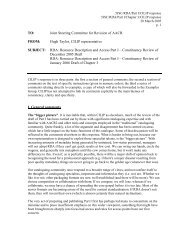
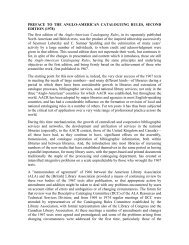
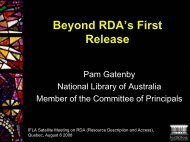



![Presentation slides [PDF] - Joint Steering Committee for ...](https://img.yumpu.com/41621230/1/190x143/presentation-slides-pdf-joint-steering-committee-for-.jpg?quality=85)

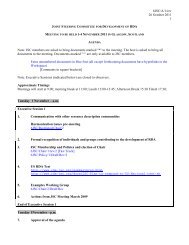
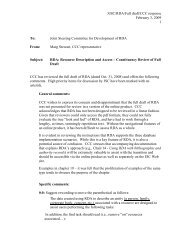
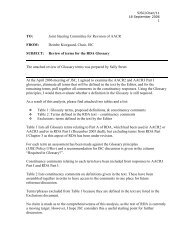
![Presentation slides [PDF] - Joint Steering Committee for ...](https://img.yumpu.com/35256207/1/190x143/presentation-slides-pdf-joint-steering-committee-for-.jpg?quality=85)
